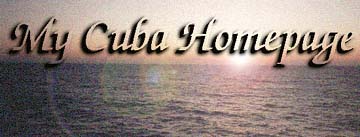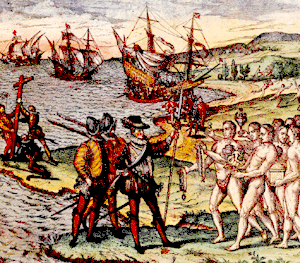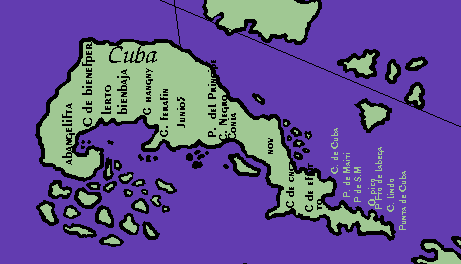
MAIN MENU
(Choose one of the options below to continue exploring this site)
![]()
![]()
![]()
![]()



Credit for the discovery of Cuba has traditionally been given to Christopher Columbus.[1] His plan of reaching the mainland of Asia via a western route across the Atlantic Ocean, though not original, led to his accidental encounter with "The New World." Of all European nations poised to undertake this sort of adventure, only Spain actually committed itself to offer financial support to Columbus. For his endeavor, Spain provided three caravels[2] and crews: the caravels Niña, Pinta, and Santa Maria.[3]
This Spanish fleet set sail from Palos de La Frontera (a harbor located in southern Spain) under the command of the Genoese mariner Christopher Columbus, on August 2, 1492. About a day later, it reached the Canary Islands-then, as now, a territory of Spain. There they stayed for about a month while repairs and modifications were done to the ships. [4] Early in September, the three caravels finally set forth to cross the Atlantic Ocean and on October 12th they discovered one of the islands of what is today the Bahamas.[5] Continuing southward, the fleet encountered several other small islands and then on October 27th, they sighted the island of Cuba (which Columbus called Juana). [6]The following day, on October 28th, 1492, Europeans for the first time in history, stepped on Cuban soil. The exact spot on which this landing took place is still in dispute, but historians generally agree that it occurred in the eastern end of Cuba.[7]

landing in the New World was probably made in
the late 16th Century by a Dutch artist.
A new governor was sent to Santo Domingo in 1509. He was Diego Columbus, the son of Christopher Columbus. The first circumnavigation of Cuba was completed at around this time and now the Spanish monarch, King Ferdinand, spurred by the belief that there was gold in Cuba, was eager to begin the colonization of the island. Having received word of the king's wishes, Diego Columbus appointed the veteran Spanish soldier Diego Velazquez to carryout the task.
In the summer of 1510 Diego Velazquez began the colonization of Cuba.[8] What insued was a guerilla war with Velazquez as leader of the occupying Spanish forces on the one side and a Native American named Hatuey leading the resistance. This war lasted a few months until the capture of Hatuey, who was subsequently burned at the stake. To this day, Hatuey is seen as a heroic figure of Cuban History. His struggle against the colonial forces and his defiance of the Spanish Empire was later emulated by other Cuban freedom fighters. Following his defeat of Hatuey, Velazquez asked his friend Bartolome de Las Casas to come to Cuba (from Hispañola). Then in 1514, Las Casas witnessed a horrible incident (the massacre of an entire village) which probably led to his conversion and ignited his belief that the Spanish were mistreating the natives.[9]

de La Cosa produced a map which represented Cuba as
an island. Cuba had initially been mistaken as being part
of the mainland. Above is an incomplete reproduction
of his original map.
Spain's main objective during this early period remained to conquer and settle the Mainland, and especially Mexico. As the western-most Spanish colony in the Caribbean, Cuba was used as a mere staging point for the expeditions that followed. To assist in this, the first African slaves were brought to Cuba in 1517. From 1517 to 1520, some 2000 Spaniards journeyed from Cuba to Mexico, most notably Francisco Hernandez de Cordoba in 1517 and Hernan Cortes in 1519. These adventurers became known in history as the infamous "Conquistadors," or Conquerors. Most of these men were soldiers of low aristocratic ranking seeking to improve their personal standing within Spanish society by acquiring land and other sources of wealth.
Efforts were made to populate Cuba, but fewer than 5000 people inhabited the island by the mid 16th Century. The combination of disease, a lack of migration to the island and attacks from pirates contributed to Cuba's slow developement. In 1524 Cuba's first governor, Diego Velazquez, died. Another major expedition to the Mainland was launched from Cuba in 1539, led by Hernando de Soto, to Florida.
In Europe, the Spanish King Charles I was at odds with the French monarch, Francis I. French Corsairs carried out attacks against the Spanish in Santiago de Cuba, and La Habana, the new capital of Cuba from 1553 onward. [10] La Habana was sacked in 1555 and virtually destroyed. As a result of these attacks, fortifications were constructed in both cities. One of Spain's greatest sea captains Pedro Menendez de Aviles was appointed Governor of Cuba in 1567. During the reign of Phillip II of Spain, war against England raged. The raids of the English pirate Francis Drake throughout America spurred the construction of more fortifications in Cuba such as El Morro in La Habana.

the close of the 16th Century.
1.) While historians have rightfully credited Christopher Columbus with the discovery of Cuba, Cuba was already inhabited by Arawak Native Americans; variously described as members of the Ciboney, Taino, and Guanajatabeye tribes.
2.) Columbus described his flagship as a "Nao." Many believe that this hints at the ship being a carrack, rather than a caravel. In my mind, all three ships were probably caravels likely ranging between 50 to 80 tons in displacement.
3.) Columbus's flagship, the Santa Maria, was originally named Mariagalante. It was later renamed Santa Maria.
4.) Most modifications entailed changing the ship's rigging to caravela redonda.
5.) San Salvador? Fill-in your favorite choice. There's too much debate still ongoing regarding this subject and no definitive answer yet.
6.) Columbus wrote in the Barcelona Letter of 1493 that when he sailed down along the coast of Juana, he found it to be so large an island that he originally believed he had encountered terra firma, that is, a part of continental Asia. He was unable to confirm his suspicion because the inhabitants ran away, out of fear.
7.) Fernando Portuondo, who I have choosen as my main source for historical information, tells us that the Spanish landed near the modern-day town of Bariay, in what was formerly Oriente Province.
8.) One of the main reasons Cuba was not colonized until 1510 was because constant rebellions in Hispañola by the natives kept the governor there too preoccupied to undertake the settlement of Cuba.
9.) Of this incident, Portuondo says that it took place near the modern-day city of Camaguey, and the account written by Las Casas states that few of the villagers were able to escape the bloodshed.
10.) Santiago de Cuba remained as the official capital of Cuba until 1607.